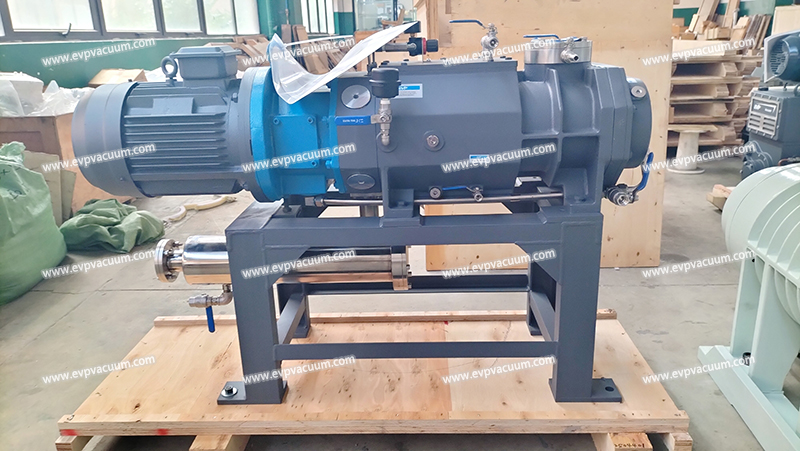Selection of screw pumps for hydrofluoric acid processing
Hydrofluoric acid is a widely used but highly corrosive and toxic chemical, primarily used in the following fields:
1.Semiconductor Manufacturing: Wafer etching and cleaning require extremely high levels of corrosion resistance and a clean, oil-free, and particle-free environment, necessitating specialized high-corrosion-resistant vacuum pumps. Preventing metal ion contamination is crucial, as purity directly determines chip yield.
2.Solar Cells and Flat Panel Displays: Etching and cleaning processes in the manufacturing process require high corrosion resistance, necessitating specialized corrosion-resistant vacuum pumps. Ensuring process cleanliness is essential to avoid affecting product performance.
3.Glass Processing: Glass etching and cleaning require vacuum pumps resistant to hydrofluoric acid corrosion. Hydrofluoric acid is highly corrosive to glass.
Core Selection Principles
1.Prioritize dry, oil-free types: This prevents the lubricating oil from reacting with hydrofluoric acid, avoids media contamination, and is suitable for handling gas/gas-liquid mixtures containing hydrofluoric acid.
2.Confirm corrosion resistance and sealing: Flow-through components must be resistant to hydrofluoric acid corrosion. The sealing structure must employ a leak-free design (such as magnetic seals or PTFE bellows seals). Ordinary mechanical seals are prohibited.
Magnetic seals typically consist of an inner magnet, an outer magnet, and a separating sleeve. Torque is transmitted through magnetic coupling to achieve a contactless seal, effectively preventing media leakage.

3.Matching Operating Parameters: Select the appropriate power and screw structure model based on hydrofluoric acid concentration (generally ≤50% or high concentration), temperature (recommended ≤120℃), and vacuum requirement (generally 1-100Pa).
Key Material Selection (Ranked by Component Priority)
1.Core Components for Flow (Screw, Pump Chamber)
– Mainstream Choices: PTFE/PVDF lining + ceramic coating (suitable for low to medium concentration hydrofluoric acid, moderate cost), duplex stainless steel + special fluoroplastic coating (stronger corrosion resistance, suitable for high concentration conditions).
– High-End Customization: Monel alloy (nickel-copper alloy, optimal resistance to hydrofluoric acid corrosion, suitable for high purity and high concentration scenarios, but must avoid oxidizing media).
– Prohibited: Ordinary stainless steel, carbon steel, conventional plastics (such as PP, PE, easily corroded by long-term penetration).
2.Seals and Sealing Components
– Sealing Structure: Magnetic seals are preferred (no risk of shaft seal leakage), followed by PTFE bellows mechanical seals (with perfluoroether O-rings).
– Sealing Materials: Sealing rings and gaskets must be made of perfluoroether rubber (FFKM) or PTFE. Nitrile rubber and fluororubber (FKM, prone to aging and failure in hydrofluoric acid environments) are prohibited.
3.Auxiliary Components
– Valve Assemblies and Piping: PVDF or PTFE materials are used. Flange gaskets are made of PTFE-coated graphite gaskets.
– Bearings: Ceramic bearings or stainless steel bearings with PTFE isolation sleeves are used to avoid contact with hydrofluoric acid vapors.
Screw pumps (even corrosion-resistant models) cannot cover all hydrofluoric acid environments. The core limitations and reasons are as follows:
1.Hydrofluoric acid systems containing solid particles: The small gap between the screw and the pump chamber allows solid particles to cause wear, pump jamming, and damage to seals and corrosion-resistant coatings.
2.Ultra-high temperature (>150℃) or ultra-high pressure conditions: High temperatures can cause PTFE linings and perfluoroether seals to age and fail, while high pressure can easily exceed the pressure resistance limit of the isolation sleeve.
3.Mixed environments of hydrofluoric acid and oxidizing media: Corrosion-resistant materials such as Monel alloy and Hastelloy alloy will corrode rapidly in hydrofluoric acid + nitric acid/hydrogen peroxide and other oxidizing media.
4.Ultra-high concentration (near anhydrous hydrofluoric acid) and high vacuum scenarios: Ordinary corrosion-resistant coatings are easily penetrated, requiring customized screw pumps with special alloys (such as tantalum alloys); standard models are not suitable.
(The article comes from the Internet. If reprinting is not allowed, please contact our company to delete it.)


